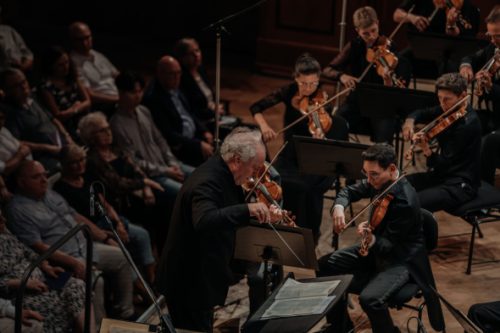 Germany Kissinger Sommer [1]: Maximilian Hornung (cello), Bamberg Symphony / Manfred Honeck (conductor). Max Littmann Hall, Bad Kissingen, 29.6.2023. (LV)
Germany Kissinger Sommer [1]: Maximilian Hornung (cello), Bamberg Symphony / Manfred Honeck (conductor). Max Littmann Hall, Bad Kissingen, 29.6.2023. (LV)

Rossini – Overture, La gazza ladra
Haydn – Cello Concerto No.2 in D major
Schubert – Symphony No.9 in C major, ‘Great’
After decades when Haydn’s C-major Cello Concerto held sway because of its relatively light technical demands and snappy, crowd-pleasing finale, the more technically difficult Cello Concerto in D major – required by every orchestra audition and cello competition – has been making a comeback, particularly on the concert stage. One of its most persuasive recent exponents has been Maximilian Hornung, whose 2015 recording with the Kammerakademie Potsdam is fast and light, deft and exhilarating.
On Thursday, Hornung took on the Concerto in D major, backed by a Bamberg Symphony that, even in reduced form (including only three double basses), was twice as big and loud as the Potsdam group; and led by Manfred Honeck, a conductor who seems to believe in the excitement that the piece can generate when played not only fast but furious. Hornung dashed along with the larger orchestra, ferociously at times, and found ingenious solutions to some of the awkward rhetorical flourishes that landmine the music. His cadenza was short and, aside from some scrunchy double-stops, appropriately brilliant.
Hornung took the slow movement at only a slightly slower pulse, played the second subject with a refreshingly lighthearted spirit, and segued quite casually into a very fast third movement that required slurred bowings from the soloist and lots of industrious work from the Bamberg strings. The speed robbed the central double-stops of their potential charm, but Hornung brought the piece home with great elan. He was more relaxed and nuanced in the first movement of Bach’s Cello Suite No.1, which made a touching encore.

After the intermission, there was no change in intensity or speed in Schubert’s big Symphony in C major. Honeck launched the introductory Andante in quick cut time, which felt rushed despite the singing quality in the strings. But it was breathlessly executed, and it made an exhilarating lead-in to an Allegro ma non troppo that seemed to be at pretty much the same speed. Honeck generated broad swaths of movement and power in the strings, the woodwinds scurried like woodland creatures, while the trombones understated legato solos and the timpanist’s soft mallets cushioned Honeck’s demands for punch. He pushed through the repeat sign and sped up as much as he could for the coda before clamping down for the last few bars and final triplets.
The slow movement moved along briskly, the woodwinds having the kind of fun you would expect from the composer’s Octet. The dynamics were carefully calculated, there were flashes of unexpected accents in the second violins, and a very long grand pause before the lovely big tune in the cellos. After a Scherzo that was one to a bar fast, impeded by occasional luftpauses, the Trio was slower with a pleasing, graceful lilt which made the return to the Scherzo seem even faster than the first time around. Making a full circle to the beginning of the concert, Honeck took the Finale: Allegro vivace as if Rossini had written it, hammer strokes in the strings leading to a crushing, abrupt end.
Honeck sent the sold-out audience home with Boccherini’s famous Minuet played by the first violins alone, with the other strings playing pizzicato.
The concert had opened with a spirited reading of Rossini’s La gazza ladra overture that was vivacious and verging on frenetic, with the orchestra equal to every challenge. The snare drummer used his instrument’s full dynamic range to lead things off, and the famous Bamberg woodwinds played their curlicues and flicks with tightly-integrated delight, while Honeck at the podium was always telling a story. As he did throughout the concert, he highlighted the drama with imaginative bowings in the strings, reflecting the fact that he is one of those exceptionally well-prepared conductors who always brings his own parts. With further injections of real excitement at the end, it was the perfect way to quick-start the concert, and it showed why the horseshoe-shaped Max Littmann Hall is regarded as one of Europe’s best.
Laurence Vittes
